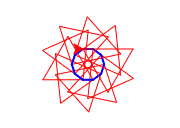Section 20.4 Nesting Loops
If we keep drawing the same shape over and over, turning slightly and/or moving between each drawing, we can make
spirograph like patterns.
The program below does this by drawing 20 pentagons. To do this, we need to repeat the pentagon recipe 20 times with a for loop. The pentagon recipe has its own for loop which repeats 5 times. A loop inside of another loop is known as a nested loop. The inner loop will do all of its repetitions for each iteration of the outer loop.
In this example, the code inside of the inner loop (forward(50) and right(72)) will be repeated 5 times and that group will be repeated 20 times. So each of those lines will happen 100 times!
By setting the pen color differently, we can distinguish the part that draws the shape from the part that draws between the shapes. The forward and right inside of the outer loop, before the second for work together to make a circle. 20 turns of 18 degrees will make a full circle of 360 degrees. At each of those 20 points, the turtle draws a pentagon.
You can use the coloring in the picture below to help you figure out the correct order of the lines below.
Checkpoint 20.4.1.
There is a way of arranging the statements below such that the image shown below is created. The turtle will draw 10 triangles. As it does so, we want it to make a full circle. Think carefully about how many degrees the turtle needs to turn at each step to make a full circle.
You will not need all of the blocks.
from turtle import *
from sys import *
mateo = Turtle()
mateo.speed(0)
---
for repeats in range(10):
---
for repeats in range(10) #paired
---
mateo.color("blue")
mateo.forward(10)
mateo.left(36)
---
mateo.color("blue")
mateo.forward(10)
mateo.left(18) #paired
---
for sides in range(3):
---
for sides in range(4): #paired
---
mateo.color("red")
mateo.forward(50)
mateo.right(120)
The following example has 3 syntax errors. Can you fix the errors so that the code compiles and runs? (None of the errors are in the numbers used - those would be logic errors, not syntax errors.)
Subsection 20.4.1 Execution Limit & Run Amok Programs
A Python program that is running in the browser has a limited amount of time it is allowed to run. If a program takes more than ~20 seconds, it will stop running even if it is not done. This can prevent complex programs from ever finishing what they are doing. Try running this program and wait until an error is printed.
Now try uncommenting these two lines:
import sys
sys.setExecutionLimit(60000)
They set the time limit for the program to 60,000 milliseconds. (One second is 1,000 milliseconds, so 60,000 milliseconds is 60 seconds.) This should give the program time to finish.
Of course we also could increase the speed of the turtle to help get the program done faster. But since there is a limit to the turtle’s speed, it may sometimes be necessary to also increase the execution limit.
If you ever get bored waiting for a program to timeout (exceed its execution limit), you can simply refresh the browser page.
Subsection 20.4.2 Indirect Nesting
It is also important to recognize that we can get the same behavior if we indirectly nest loops. The sample below has a square procedure with a loop. The main part of the program has a loop as well and that loop calls the square procedure inside of it. So the lines inside square’s loop get executed 40 total times - the loop in main calls square 10 times and each call to square repeats them 4 times.
Normal nested loops can get difficult to read once you have multiple “levels” of loops all stacked inside of each other. The “indirect” nesting, where the inner loop is hidden inside of a procedure makes the main part of the program a bit easier to read. Compare this program to the one at the top of the page. It is much easier to see that this program draws 10 squares than it was to see that the first one drew 20 pentagons. We had to use a comment in the first one just to try to make things clear.
You have attempted
of
activities on this page.

